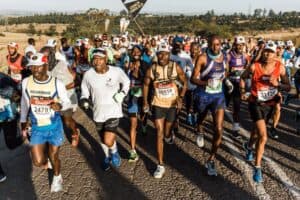Training tips from the nine-time Comrades winner.

The mornings are cooler, the leaves have started to fall, it’s dark for longer during the morning training runs, the country road cosmos flowers are in full bloom, everyone is tired and now it’s time for Comrades Marathon runners to contemplate those long training runs that are a very important part of every training programme.
By now Comrades runners will be all too familiar with the regular grind of weekend 30, 40 and 50km training runs
and races.
I chatted to some of them at last weekend’s Run Zone 32km race in Johannesburg.
“Tiredness” and “heavy legs” were recurring words in our chats, as was the realisation that April, “the cruellest training month”, is upon them and that the 32km they were running on Sunday was probably the shortest long run they will tackle for quite a few weeks.
April really is the important Comrades training month and the race’s most experienced runners understand that a good solid month of training in April usually results in a successful Comrades in June. As I discussed in an earlier column it really doesn’t matter how badly training might have gone in January or February or even how well it went.
It is the eight to 10-week training phase in which runners are now deeply immersed that determines the outcome in June.
And the cornerstones of this important time are the weekend long runs.
These runs vary in length from 40km and longer and may be as long as 70km.
The popular thinking behind these long runs is that they build the stamina, endurance and strength considered so necessary for Comrades.
I remember as a young Wits runner preparing for my first Comrades on an April Sunday in 1977 running with a group somewhere far away beyond Muldersdrift, being encouraged by some veterans to keep on grinding out the kilometres.
I had had enough and was sunburnt and irritable and I was nursing a nagging plantar tendon.
But I was told to keep plodding on in order to build physical endurance and mental tenacity.
When I complained about the boredom and the toil, the veterans reminded me that the great Wally Hayward used to run back-to-back weekend long runs from his house in Edenvale to the Pretoria Fountains.
After a quick wash in the fountains he would run home.
That was two weekend runs of over 70km.
I’ve never been completely convinced about the real advantages of these long runs, but I suppose I was coaxed and enticed into believing in their benefits because of the era in which my running journey began.
Many of the modern era champions still seem to run very long runs, though it is interesting to note that Leonid Shvetsov, the men’s Up run record holder, never ran one single training run longer than 35km.
He did however run several training weeks in excess of 200km.
The important lesson about the long run should be that its benefit lies not in the distance covered, nor in the speed at which it is run, but in the time a runner spends on his or her feet.
I have always believed the real benefit of the Comrades long run is to get the legs used to being in a vertical position for as long as possible.
That is one of the great challenges of the Comrades Marathon.
While tackling the race Comrades runners have to spend hours in a vertical position without the opportunity to rest tired legs by sitting or lying down.
I have a lot of affection for G and H batch runners at Comrades.
They are the true heroes.
The G and H batch heroes are the runners who spend the most time on the road and the ones who get true value for every cent of their entry fee.
Most of them start the race in the dark and end it in Scottsville in the dark.
The least fit of the 20 000 starters and the most genetically unsuited for the challenge, these G and H batch runners truly embody the spirit of the Comrades.
Obviously they are also the runners who have to spend the most time standing at Comrades.
In dance marathons during the Depression, the last couple still dancing would win the few thousand dollars prize money.
After many hours the couples would cling to each other desperately trying to stay upright as their opponents staggered and fell.
In a sense every Comrades runner runs their own dance marathon to Pietermaritzburg and G and H batch runners have to be the last to drop.
So, the primary role of the long run is to accustom runners to defying gravity for many hours. Speed and distance
covered are irrelevant.
On that first long run back in 1977 the veterans around me encouraged me not to sit down, not to lean on the tailgate of the drinks truck that was following us and not to stretch against a beckoning lamp post.
They understood the meaning and importance of the words “time on your legs”.
There are three unnamed hills just after the village of Camperdown in the Up Comrades.
The third is a particularly nasty surprise and would be called “Coronary Thrombosis Heights” if it was a feature of any other marathon.
At that point, runners have roughly a half marathon still to run.
A third of the way up the hill a lone tree casts a welcome pool of shade.
As always on race afternoon this year the enticing shade of this tree will be packed with tired, groaning runners lying, sitting and trying to gather the strength to battle on.
The problem is that while they lie there the clock is running and they are not.
Those who have managed their long runs correctly will shuffle on without stopping.
For more sport your way, download The Citizen’s app for iOS and Android.






